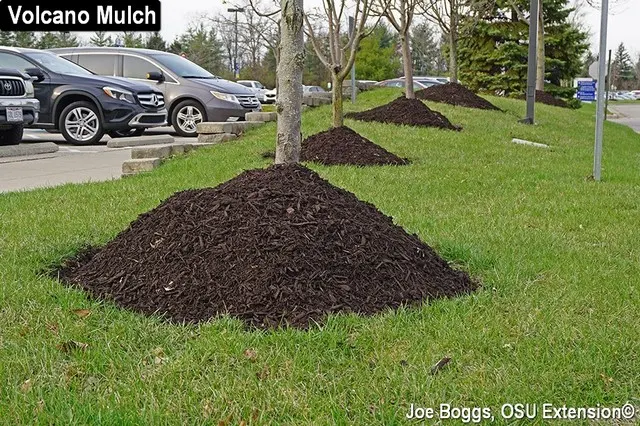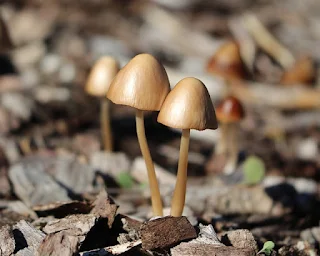 |
| Mulch volcano. Photo by Joe Boggs, OSU Extension |
Mulch is a widely celebrated tool in the landscaping and gardening world, prized for its ability to conserve soil moisture, suppress weeds, and regulate soil temperature. However, its misuse, particularly in the form of 'mulch volcanoes', can pose severe risks to plant health.
This was a new one to me! You see these 'mulch volcanoes' everywhere so I generally thought nothing of it, but I stumbled upon some information recently that proved that notion quite wrong! No more mulch volcanoes! This isn't a middle school science project! No streetside Vesuvius! What's next, mixing baking soda and vinegar into the mulch?? Please don't hire Dante's Peak Landscaping for the job.
What is a Mulch Volcano?
A mulch volcano is a term used to describe an all-too-common landscaping practice where mulch is piled high against the trunk of a tree or the base of a shrub or plant. The name stems (no pun intended) from its appearance: the base of the plant or tree trunk becomes buried deep within the peak of a mound, making it resemble the shape of a volcano with the tree or shrub emerging from its peak.
You're probably very familiar with this shape but in reality its lazy and bad landscaping! What makes this so?
Why are Mulch Volcanoes bad?
Mulch volcanoes are bad for several reasons, mostly involving the health, vitality, and integrity of the tree or plant. We'll go into detail of the main reasons. |
| Root problems post mulch volcano Pic by FieldsofBlue on Reddit |
Why does this all matter? Well, low-oxygen conditions promote fungi and bacteria causing root rot and suffocated roots struggle to absorb water and nutrients, leading to deficiencies. Even more-so, stressed plants with limited oxygen become more prone to diseases and pests.
Trees under these conditions may also form 'girdling roots' which are surface roots or circular roots that can strangle the tree over time. Feel free to be a tree-hugger, but please don't be a tree strangler!
Bark Decay:
A tree's bark acts as a protective shield, safeguarding it from various external threats and keeping its inner tissues intact. When mulch is piled directly against the tree's trunk, it tends to retain and trap moisture against the bark.This prolonged moisture exposure can cause the bark to soften, compromising its protective qualities. Softened bark is more susceptible to invasion by pathogens, particularly fungi that flourish in damp conditions.
Additionally, certain pests are attracted to such areas of weakened or decaying bark because it offers easier access to the tree's nutrient-rich inner tissues.
Over time, this can lead to significant bark decay, jeopardizing the tree's overall health, reducing its life expectancy, and making it more prone to structural issues or failures.
Thus, while mulch is beneficial for soil and plant growth, it's crucial to ensure it doesn't directly contact a tree's trunk to prevent potential bark decay and associated problems.
Pest Harborage:
Mulch volcanoes create a unique environment that is moist, sheltered, and close to food sources, which is highly appealing to certain pests, notably rodents like voles and mice.The consistent moisture and protection from predators make the base of the tree an ideal nesting or hiding spot. Once these rodents establish themselves in the mulch, they often find the softened bark of the tree an easily accessible food source.
By feeding on the bark, they strip away the tree's protective layer, exposing the inner tissues and making it susceptible to infections and diseases.
Over time, if this feeding continues unchecked, problems may erupt leading to significant damage, impeding the tree's ability to transport nutrients effectively, which in turn can affect the tree's overall health and vitality.
Exposure to Temperature Extremes
Mulch, in its proper application, acts as an insulator for the soil, moderating temperature fluctuations and helping to protect plant roots from sudden or extreme temperature changes. However, when mulch is applied excessively, it can have unintended consequences on the soil's temperature dynamics.Excessive mulch layers can trap too much heat, especially during the warmer months. This is particularly true for certain types of mulch, like darker wood chips, which can absorb and retain significant amounts of sunlight. When the mulch gets overly hot, it can increase the temperature of the underlying soil, potentially stressing or damaging the sensitive roots below.
Conversely, during colder periods, an overly thick layer of mulch might prevent the soil beneath from warming up effectively. Soil generally has a buffering capacity against rapid temperature changes, but if it's insulated too much by excessive mulch, it might remain too cold for extended periods, hindering root activity and growth.
In both scenarios, whether the soil becomes too hot or remains too cold, the result is sub-optimal conditions for root health. Roots operate best within specific temperature ranges, and deviations from these ranges can reduce their ability to absorb nutrients and water, leading to weakened or stressed plants.
Ideal Mulching Techniques
The correct purpose of mulch is to protect the soil around a plant, maintaining moisture, preventing erosion, and suppressing weeds. It's not intended to come into direct contact with the plant's trunk or main stems. Whooda thunk?
Shape & Depth:
- The 'Donut' Analogy: The ideal mulching technique emphasizes not piling mulch against a tree's trunk or a shrub's base. Just like a donut has a hole in the center, the area immediately around the base of the plant should be free of mulch. This design ensures that the base can breathe and avoids potential issues like bark decay.
- Depth Matters: Applying a mulch depth of 2-4 inches strikes a balance between retaining soil moisture and preventing too much water retention. Deeper mulch can stifle the soil, while shallow mulch may not offer adequate protection against weeds or evaporation. However, specifics can vary depending on regional climate, soil type, and the mulch material used.
Type of Mulch
- Organic vs. Inorganic: Organic mulches, such as wood chips, straw, or bark, are derived from once-living materials. As they break down, they enrich the soil with organic matter, fostering a healthy microbial environment and gradually improving soil structure. Inorganic mulches, like rubber chips or gravel, won’t decompose and provide soil enrichment, but they may serve other purposes like decorative landscaping or pathways.
- Choosing the Right Fit: While organic mulches generally offer more benefits for plants and soil health, the choice between organic and inorganic should factor in the specific needs of the plants, the aesthetic preferences of the gardener, and the intended purpose of the mulched area.
Frequency
- Decomposition Dynamics: Organic mulch doesn't stay the same over time. As it breaks down, it releases nutrients into the soil, but it also diminishes in volume.
- Replenishing Thoughtfully: It's tempting to add a new layer of mulch annually or when the mulch looks sparse, but it's crucial to check the existing depth first. Over-mulching, or piling on too much over time, can create a barrier that's too dense for water to penetrate or for roots to breathe. Before reapplying, gardeners should remove some of the old mulch or mix it into the soil to maintain the ideal depth.
Will you help let the world know about the harm of Mulch Volcanoes?

No comments:
Post a Comment